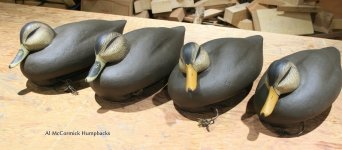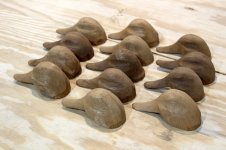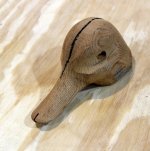Steve Sanford
Well-known member
Good morning, All~
This past Fall - and holiday season - has been flat-out at Pencil Brook Farm (and Boatworks and Decoy Infirmary....)
This past Tuesday was the end of looming/overdue deadlines for me - when I mailed off this outboard cover for this Mariner.

After finally fixing the dreaded "lower thread tension" on my SailRite sewing machine, I was able to complete this cover - from Sunbrella and polypropylene webbing.

Because of my sewing machine troubles, it could not be delivered to Long Island with this South Bay the week before.

Another delinquent project was the finishing of 13 Black Duck heads - either made by Al McCormick or to his plans.

Most Long Island gunners know the name Al McCormick as Mister Decoy. For several decades he made - and more important helped many others make - some exceptional gunning decoys. He was especially famous for his Black Ducks - THE puddle duck on Long Island. This bird has a re-painted head.

Here is Al's paint - on a bird he signed - and is a prized member of my collection. Spray on the crown and cheeks, a brushed on eye-stripe - and NO glass eyes. (NOTE: Al used black cork for the bodies and filled all of the crevices with a slurry of cork dust and varnish.)

Although I never worked with Al, I did visit his basement workshop and watched him create decoys for many years at the U S National Decoy Show. I have, though, re-painted scores of his birds for others. Here are some McCormick Broadie-beaks with my paint.

Here are some McCormick Standard Blacks - again with my paint.

Here are some of his later Humpbacks.

Someone - maybe moi ? - put eyes in these Standards.

BTW: Here are the Behr paints I use (shown on a Wildfowler Superior Model with a scratch-painted face). Al had stock Benjamin Moore colors he used - but this old brain cannot recall the names. Maybe Tudor Brown for the bodies???

As you will see, all of the 13 heads in this project are the same posture - what Al called his Bull Heads. It is unusual only because Al carved many head postures. Note at the top of the page his recommendations for the mix in a perfect rig. He does not show a profile view of his No. 10 Bull Head (at upper right).

Stay tuned.....
SJS
This past Fall - and holiday season - has been flat-out at Pencil Brook Farm (and Boatworks and Decoy Infirmary....)
This past Tuesday was the end of looming/overdue deadlines for me - when I mailed off this outboard cover for this Mariner.

After finally fixing the dreaded "lower thread tension" on my SailRite sewing machine, I was able to complete this cover - from Sunbrella and polypropylene webbing.

Because of my sewing machine troubles, it could not be delivered to Long Island with this South Bay the week before.

Another delinquent project was the finishing of 13 Black Duck heads - either made by Al McCormick or to his plans.

Most Long Island gunners know the name Al McCormick as Mister Decoy. For several decades he made - and more important helped many others make - some exceptional gunning decoys. He was especially famous for his Black Ducks - THE puddle duck on Long Island. This bird has a re-painted head.

Here is Al's paint - on a bird he signed - and is a prized member of my collection. Spray on the crown and cheeks, a brushed on eye-stripe - and NO glass eyes. (NOTE: Al used black cork for the bodies and filled all of the crevices with a slurry of cork dust and varnish.)

Although I never worked with Al, I did visit his basement workshop and watched him create decoys for many years at the U S National Decoy Show. I have, though, re-painted scores of his birds for others. Here are some McCormick Broadie-beaks with my paint.

Here are some McCormick Standard Blacks - again with my paint.

Here are some of his later Humpbacks.

Someone - maybe moi ? - put eyes in these Standards.

BTW: Here are the Behr paints I use (shown on a Wildfowler Superior Model with a scratch-painted face). Al had stock Benjamin Moore colors he used - but this old brain cannot recall the names. Maybe Tudor Brown for the bodies???

As you will see, all of the 13 heads in this project are the same posture - what Al called his Bull Heads. It is unusual only because Al carved many head postures. Note at the top of the page his recommendations for the mix in a perfect rig. He does not show a profile view of his No. 10 Bull Head (at upper right).

Stay tuned.....
SJS





















